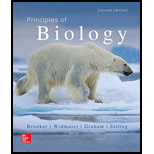
Principles of Biology
2nd Edition
ISBN: 9781259875120
Author: Robert Brooker, Eric P. Widmaier Dr., Linda Graham Dr. Ph.D., Peter Stiling Dr. Ph.D.
Publisher: McGraw-Hill Education
expand_more
expand_more
format_list_bulleted
Concept explainers
Question
Chapter 17, Problem 1CBQ
Summary Introduction
To determine:
The particular virus associated with societal and medical issues.
Introduction:
A virus is a small infectious agent that causes infection to replicate inside the living cells and organisms. The science that deals with the study of the virus is known as virology.
Expert Solution & Answer
Want to see the full answer?
Check out a sample textbook solution
Students have asked these similar questions
A 25-year-old woman presents to the emergency department with a 2-day history of fever, chills, severe headache, and confusion. She recently returned from a trip to sub-Saharan Africa, where she did not take malaria prophylaxis. On examination, she is febrile (39.8°C/103.6°F) and hypotensive. Laboratory studies reveal hemoglobin of 8.0 g/dL, platelet count of 50,000/μL, and evidence of hemoglobinuria. A peripheral blood smear shows ring forms and banana-shaped gametocytes. Which of the following Plasmodium species is most likely responsible for her severe symptoms?
A.
Plasmodium vivax
B.
Plasmodium ovale
C.
Plasmodium malariae
D.
Plasmodium falciparum
Standard Concentration (caffeine) mg/L
Absorbance Reading
10
0.322
20
0.697
40
1.535
60
2.520
80
3.100
Please draw in the missing answer, thank you
Chapter 17 Solutions
Principles of Biology
Ch. 17.1 - Prob. 1CCCh. 17.1 - Prob. 1BCCh. 17.1 - Prob. 1TYKCh. 17.1 - The step in the viral cycle that follows...Ch. 17.2 - Prob. 1CCCh. 17.2 - Prob. 1BCCh. 17.2 - Describe how the loop domains are held in place.Ch. 17.2 - Prob. 3CCCh. 17.2 - Prob. 4CCCh. 17.2 - Prob. 1TYK
Ch. 17.2 - Prob. 2TYKCh. 17.2 - Prob. 3TYKCh. 17.3 - Prob. 1CCCh. 17.3 - Prob. 1BCCh. 17.3 - Prob. 2CCCh. 17.3 - Prob. 1TYKCh. 17.3 - Prob. 2TYKCh. 17 - Prob. 1TYCh. 17 - Which of the following does hot describe a typical...Ch. 17 - Prob. 3TYCh. 17 - Prob. 4TYCh. 17 - Prob. 5TYCh. 17 - Genetic diversity is not maintained in bacterial...Ch. 17 - Prob. 7TYCh. 17 - Prob. 8TYCh. 17 - Prob. 9TYCh. 17 - Prob. 10TYCh. 17 - How are viruses similar to and different from...Ch. 17 - Describe the three mechanisms of gene transfer in...Ch. 17 - Prob. 3CCQCh. 17 - Prob. 1CBQCh. 17 - Conjugation is sometimes called bacterial mating....
Knowledge Booster
Learn more about
Need a deep-dive on the concept behind this application? Look no further. Learn more about this topic, biology and related others by exploring similar questions and additional content below.Similar questions
- a. On this first grid, assume that the DNA and RNA templates are read left to right. DNA DNA mRNA codon tRNA anticodon polypeptide _strand strand C с A T G A U G C A TRP b. Now do this AGAIN assuming that the DNA and RNA templates are read right to left. DNA DNA strand strand C mRNA codon tRNA anticodon polypeptide 0 A T G A U G с A TRParrow_forwardplease answer all question below with the following answer choice, thank you!arrow_forwardplease draw in the answeres, thank youarrow_forward
- A) What is being shown here?B) What is indicated by the RED arrow?C) What is indicated by the BLUE arrow?arrow_forwardPlease identify the curve shown below. What does this curve represent? Please identify A, B, C, D, and E (the orange oval). What is occurring in these regions?arrow_forwardPlease identify the test shown here. 1) What is the test? 2) What does the test indicate? How is it performed? What is CX? 3) Why might the test be performed in a clinical setting? GEN CZ CX CPZ PTZ CACarrow_forward
- Determine how much ATP would a cell produce when using fermentation of a 50 mM glucose solution?arrow_forwardDetermine how much ATP would a cell produce when using aerobic respiration of a 7 mM glucose solution?arrow_forwardDetermine how much ATP would a cell produce when using aerobic respiration to degrade one small protein molecule into 12 molecules of malic acid, how many ATP would that cell make? Malic acid is an intermediate in the Krebs cycle. Assume there is no other carbon source and no acetyl-CoA.arrow_forward
arrow_back_ios
SEE MORE QUESTIONS
arrow_forward_ios
Recommended textbooks for you
 Medical Terminology for Health Professions, Spira...Health & NutritionISBN:9781305634350Author:Ann Ehrlich, Carol L. Schroeder, Laura Ehrlich, Katrina A. SchroederPublisher:Cengage LearningLifetime Physical Fitness & WellnessHealth & NutritionISBN:9781337677509Author:HOEGERPublisher:Cengage
Medical Terminology for Health Professions, Spira...Health & NutritionISBN:9781305634350Author:Ann Ehrlich, Carol L. Schroeder, Laura Ehrlich, Katrina A. SchroederPublisher:Cengage LearningLifetime Physical Fitness & WellnessHealth & NutritionISBN:9781337677509Author:HOEGERPublisher:Cengage

Medical Terminology for Health Professions, Spira...
Health & Nutrition
ISBN:9781305634350
Author:Ann Ehrlich, Carol L. Schroeder, Laura Ehrlich, Katrina A. Schroeder
Publisher:Cengage Learning


Lifetime Physical Fitness & Wellness
Health & Nutrition
ISBN:9781337677509
Author:HOEGER
Publisher:Cengage



What Is A Virus ? ; Author: Peekaboo Kidz;https://www.youtube.com/watch?v=YS7vsBgWszI;License: Standard YouTube License, CC-BY